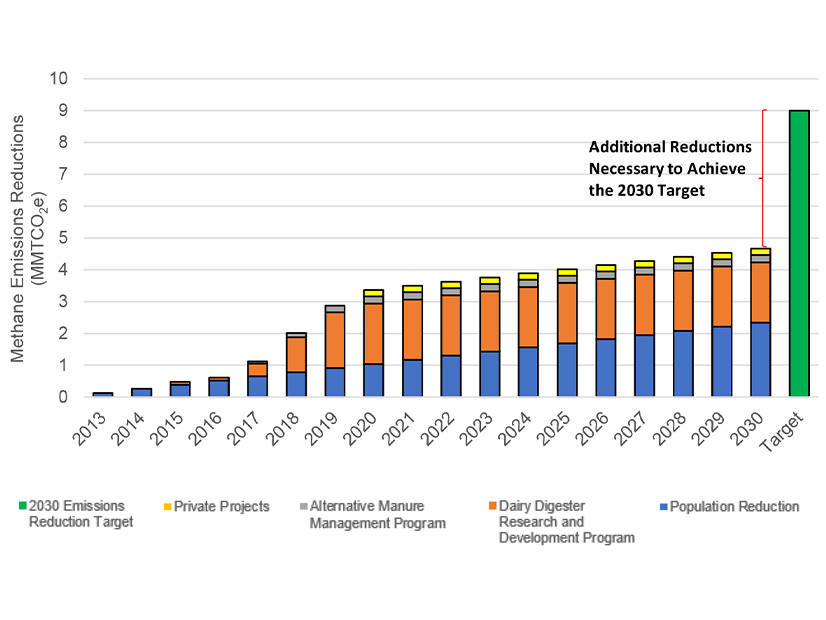
California is about halfway to meeting a 2030 dairy methane reduction target, and it could cost as much as $3.9 billion to get the rest of the way there, according to a new report from the state’s Air Resources Board.
Progress on meeting the goal has been boosted by $289 million from California Climate Investments, a program that distributes proceeds from the state’s cap-and-trade program to help reduce greenhouse gas emissions. The program has funded 233 dairy and livestock GHG emissions reduction projects.
The cost to further reduce emissions to reach the 2030 goal depends on the types of projects and technology involved, according to the report, which the California Air Resources Board (CARB) released last week.
On the high end of the cost range, rolling out an additional 230 manure digester projects that use fuel cell technology would cost an estimated $3.9 billion. If the digesters used internal combustion engines instead, the cost would drop to $700 million. But that technology would increase on-site pollution, according to the report, which envisions a range of funding sources.
“New or expanded local, state or federal incentives or funding mechanisms could potentially accelerate the capture and beneficial use of California biomethane, provide additional revenue necessary to ensure that California’s dairy manure methane emissions are captured, and direct the biogas to difficult-to-decarbonize sectors,” the report said.
CARB also hosted a workshop last week on methane, dairies and renewable natural gas in California.
Range of Strategies
California’s dairy and livestock sector produces more than half of the state’s emissions of methane, a short-lived climate pollutant and potent greenhouse gas.
Cows burp out methane produced in the digestive process, and methane is released during anaerobic processing of the animals’ manure.
Senate Bill 1383, adopted in 2016, set a statewide target to reduce the dairy and livestock sector’s methane production by 40% below 2013 levels by 2030.
Dairy digesters are one way to reduce methane emissions. The digesters collect methane produced during anaerobic manure digestion. The biomethane then has a variety of potential uses: generating electricity that can be used on site or sent to the grid, fueling vehicles or being injected into the natural gas pipeline system after it has been upgraded to meet specifications.
Digesters have contributed a dairy methane reduction of about 2 million metric tons of CO2 equivalent, or about 20% of the 2030 target, according to CARB’s report.
Another way to reduce dairy methane is through alternative manure management, in which manure is exposed to air during processing to stop methane production. In one such practice, animals are allowed to spend more time in the pasture.
In addition, research is ongoing on food additives that may reduce the amount of methane that cows burp, known as enteric emissions.
And a decrease in the number of cows statewide is reducing dairy methane, a trend that’s expected to continue.
“A combination of dairy digesters, alternative manure management, enteric strategies and dairy herd size population decreases will be needed to meet the 2030 target,” CARB said in its report.
Digester Debate
Several programs can serve as incentives for dairies to install digesters. Digester-produced biomethane may be eligible for credits in CARB’s low-carbon fuel standard (LCFS) program, the federal Renewable Fuels Standard or CARB’s cap-and-trade offsets program.
The programs “act as an ongoing revenue stream for facilities to help offset the initial high capital costs of development as well as support the ongoing operational costs of the digester,” CARB said in its report.
But critics say the programs create an incentive for dairies to expand, increasing environmental and health impacts on surrounding disadvantaged communities. And some say the LCFS overstates the climate benefit of using the digester-produced biomethane as a transportation fuel. (See CARB Promises Closer Look at Biomethane Role in LCFS.)
Some have suggested that large California dairies may be making more money from the so-called “factory farm gas” than they do from milk.
The latter question was discussed during CARB’s workshop last week.
Aaron Smith, a professor of Agricultural and Resource Economics at the University of California, Davis, presented an analysis of dairy costs and revenues in the third quarter of last year.
Making several assumptions based on a herd size of 2,000, Smith found that the main component of biogas revenue was LCFS credits, followed by credits from the federal Renewable Fuel Standard program. Revenue from the gas itself was only a sliver of the total.
Smith described the total revenue as “much, much larger” than the digester cost, “which is largely what has fueled this massive growth that we’ve seen in digesters.”
The total biogas revenue in Smith’s analysis was slightly more than half the value of milk produced by the dairy.
“What these large subsidies do, is they do change the economics of dairy farms,” Smith said.
Another workshop speaker was Sam Wade, director of public policy for the Coalition for Renewable Natural Gas, who disputed Smith’s findings.
Wade said the volatility of credit prices must be kept in mind. LCFS prices, for example, have ranged from $22 to $206 per credit, he said.
“It’s not fair to just look at the prices when we’ve been at peak and sort of assume from that that these projects are making a huge amount of return,” Wade said.
Grants to partially cover capital costs of digesters were initially offered, Wade said, but digester projects didn’t really take off until credit programs were added. The idea is that revenue from the environmental credits will cover digester operating costs and pay back a significant share of the capital costs, he said.
“Only recently has the mix of federal and state incentives been successful at promoting digester project development in California,” Wade said. “Diminishing those incentives would slow progress and risk non-achievement of our methane-reduction goals.”
